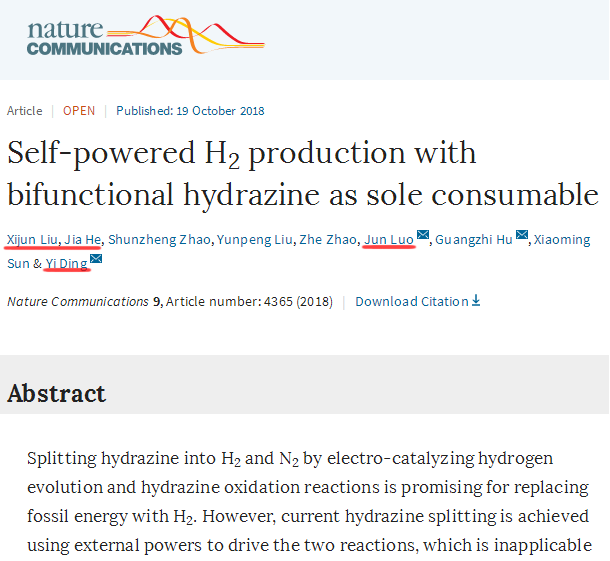Electrolysis of water or hydrazine is an effective pathway of producing hydrogen, but often requires an external power source, which limits outdoor hydrogen production. In response to this challenge, researchers and collaborators from the School of Materials Science and Engineering, Institute for New Energy Materials and Low-Carbon Technologies, Tianjin Key Laboratory of Advanced Functional Porous Materials and Center for Electron Microscopy, Tianjin University of Technology, have proposed for the first time a self-powered hydrogen production system based on hydrazine splitting. Related study “Self-powered H2 production with bifunctional hydrazine as sole consumable" has been published in recent Nature Communications (2018, 9, 4365). (https://www.nature.com/articles/s41467-018-06815-9)

In the article, a novel electrocatalyst for hydrazine splitting - Fe-doped CoS2 nanosheet was reported. With Fe-CoS2 based electrodes, direct hydrazine fuel cells and overall-hydrazine-splitting units were realized and integrated to form a self-powered H2 production system (as shown in the figure below).The H2 production system exhibits a high hydrogen revolution rate of 9.95 mmol/h (catalyst loading is 0.5 mg/cm2), a Faradaic efficiency of 98%, and a 20-hour stability of working voltage and production rate. Hydrazine serves bifunctionally in the system as the DHzFC fuel and the splitting target. The study also revealed that Fe doping decreased the free-energy changes of H adsorption as well as the dehydrogenation of adsorbed NH2NH2* on CoS2.

The first author affiliation of the research article is Tianjin University of Technology. The corresponding authors are Prof. Jun Luo, Guangzhi Hu (XTIPC.CAS) and Prof. Yi Ding. The first authors are our university lecturers, Dr. Xijun Liu and Dr. Jia He, from University of Science and Technology in Beijing. Collaborators from University of Science and Technology in Beijing, IHEP.CAS and Beijing University of Chemical Technology also participated in the study.The paper was sponsored by National Key R&D Program of China, National Natural Science Foundation of China, Tianjin Municipal Education Commission and Tianjin Science and Technology Commission.

